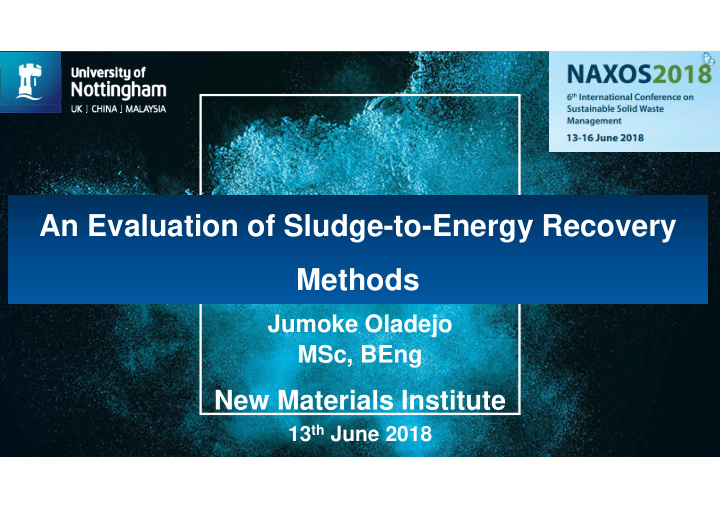



An Evaluation of Sludge-to-Energy Recovery Methods Jumoke Oladejo MSc, BEng New Materials Institute 13 th June 2018
Outline • Overview • Pre-Processing • Anaerobic Digestion • Combustion • Pyrolysis • Gasification • Conclusion
Sewage Sludge…. Waste or Resource?
What is Sewage Sludge Global water use Waste Water treatment Facility Sewage Sludge
Sewage Sludge Use Treated Sludge can be used for various agricultural, construction or energy applications. However, landfilling and incineration remains prominent.
Why Sludge – to - Energy So, What are the drawbacks to “sewage sludge“ present use? - Growing waste management issues - Hindering policies and regulations for carbon disposals - Increasing price of disposal - Wastage of potential resource - Pollutants considerations Dumping into Water bodies Landfill or Buried dumping Incineration
Energy Recovery from Sludge
Sludge - to - Energy Recovery Methodss Energy Content - 11.10 – 22.10 MJ/ Kg First principle of circular economy: “Waste is either a resource, food, energy or m oney…… zero waste and pollution” “
Pre-Processing of Sludge Sludge thickening, dewatering and drying process Sludge Thickening – similar to sedimentary tanks for increasing solid contents by removal of some liquid fraction Sludge Dewatering – Use of mechanical or chemical assisted system to reduce water content Sludge Drying – Use of thermal treatment to obtain granular sludge that can be easily handled
Anaerobic Digestion Biological process for biogas production Globally accepted and technologically mature. Biogas (60 – 70% methane) Energy content of biogas 13 – 21 MJ/ kg³ Potential to offset 50% energy requirement Risk of non-utilisation or flaring of biogas Profitability dependent on scale Improvement of digestion rate Enhancement of biogas yield and quality Current research focussed on various chemical, mechanical and thermal pre- treatment methods to enhance digestion rate and yield.
Combustion High temperature oxidation for heat and electricity generation Technologically mature process Flue gas cleaning facility Operation challenges – moisture and ash content Moisture = inefficiency and low heating value Ash slagging = inefficiency and reactor maintenance C0-utilization with coal or biomass Current research focussed on pre-treatm ents, optim isation of com bustion param eters, catalysts usage, m inim isation of pollutants form ation, and heavy m etals retention in ash to im prove com bustion suitability and m inim ise deterrent factors.
Pyrolysis Inert atmosphere thermal decomposition for bio-oil, char and gas. Not a technologically mature process Bio-oil with ~ 33 MJ/ Kg heating value Negligible pollutant and heavy metal emission Operation challenges – moisture and char content Moisture = inefficiency, low oil quality. Char = Ash catalytic cracking, disposal or use in circular economy Current research focussed on pre-treatm ents, optim isation of pyrolysis param eters to enhance bio-oil and gas yield, catalysts, m inim isation of pollutants or heavy m etals em ission, downstream use of yields to ensure profitability and efficiency of technology.
Gasification Partially oxidized thermal decomposition for gaseous yield. Not a technologically mature process Synthesis gas with ~ 4 – 12 MJ/ m 3 Pollutants formation – H 2 S, NH 3 , SO x & NO x Moisture = inefficiency, tar formation. Ash = clinker formation, heavy metal emissions, disposal or use Current research focussed on pre-treatm ents, optim isation of gasifier param eters to enhance syngas and H 2 yield, catalysts and m inim isation of tar, pollutants and heavy m etals em ission to ensure profitability and efficiency of technology.
Concluding Remarks
Concluding Remarks • Environmental limitations of sludge disposal requires its use as a resource • Further work in sludge characterization, co-utilization of sludge, operating condition optimization required. • High moisture and ash content are the main obstacle. • Use of catalysts, coupling of various technologies and co-use of sludge with other fuel types are high potential routes for future commercial scale-up. • In-depth feasibility, technical, economic, social and life cycle assessment required for establishing suitability in the low carbon circular economy.
Thank you Xie Xie Danke sha Gracias Merci
Questions???
Recommend
More recommend